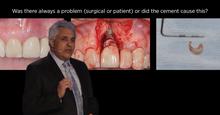-
0
Patient Assessment
- 0.1 Patient Demand
- 0.2 Anatomical location
-
0.3
Patient History
- 2.1 General patient history
- 2.2 Local history
-
0.4
Risk Assessment
- 3.1 Risk Assessment Overview
- 3.2 Age
- 3.3 Patient Compliance
- 3.4 Smoking
- 3.5 Drug Abuse
- 3.6 Recreational Drug and Alcohol Abuse
- 3.7 Condition of Natural Teeth
- 3.8 Parafunctions
- 3.9 Diabetes
- 3.10 Anticoagulants
- 3.11 Osteoporosis
- 3.12 Bisphosphonates
- 3.13 MRONJ
- 3.14 Steroids
- 3.15 Radiotherapy
- 3.16 Risk factors
-
1
Diagnostics
-
2
Treatment Options
-
2.1
Treatment planning
- 0.1 Non-implant based treatment options
- 0.2 Treatment planning conventional, model based, non-guided, semi-guided
- 0.3 Digital treatment planning
- 0.4 NobelClinician and digital workflow
- 0.5 Implant position considerations overview
- 0.6 Soft tissue condition and morphology
- 0.7 Site development, soft tissue management
- 0.8 Hard tissue and bone quality
- 0.9 Site development, hard tissue management
- 0.10 Time to function
- 0.11 Submerged vs non-submerged
- 0.12 Healed or fresh extraction socket
- 0.13 Screw-retained vs. cement-retained
- 0.14 Angulated Screw Channel system (ASC)
- 2.2 Treatment options esthetic zone
- 2.3 Treatment options posterior zone
- 2.4 Comprehensive treatment concepts
-
2.1
Treatment planning
-
3
Treatment Procedures
-
3.1
Treatment procedures general considerations
- 0.1 Anesthesia
- 0.2 peri-operative care
- 0.3 Flap- or flapless
- 0.4 Non-guided protocol
- 0.5 Semi-guided protocol
- 0.6 Guided protocol overview
- 0.7 Guided protocol NobelGuide
- 0.8 Parallel implant placement considerations
- 0.9 Tapered implant placement considerations
- 0.10 3D implant position
- 0.11 Implant insertion torque
- 0.12 Intra-operative complications
- 0.13 Impression procedures, digital impressions, intraoral scanning
- 3.2 Treatment procedures esthetic zone surgical
- 3.3 Treatment procedures esthetic zone prosthetic
- 3.4 Treatment procedures posterior zone surgical
- 3.5 Treatment procedures posterior zone prosthetic
-
3.1
Treatment procedures general considerations
-
4
Aftercare
Screw-retained restorations, posterior zone
Key points
- The choice to screw or cement retain an implant crown is determined by the restorative dentist, many times without patient input.
- Screw retention provide retrievability but may compromise esthetics and strength.
- Cementing implant retained full crowns may lead to late implant failure.
Considerations for screw-retained design in the posterior zone
The choice of whether to screw or cement retain an implant restoration remains one of debate amongst dental professionals. The literature is consistent that the success of both options are very high. Complication rates of both are essential identical (3-5%).
The rationale for screw retention is the retrievability of the restoration. This is a luxury that does not exist in conventional fixed prosthodontics on teeth. As a result, any complication with the restoration can be more easily addressed, the screw retained restoration is easily removed which allows for repair or examination of soft tissue and direct visualization of the implant. This also negates the need to remake the restoration as in cement retained options. With the development of the Angulated Screw Channel (ASC) the ability to utilize the screw retained option has been expanded. With angulations of up to 25° from the long axis of the implant it is still possible to fabricate a screw retained restoration. The disadvantage to the screw retained option has been the concern over the visibility of the access channel. With the improved esthetic materials, ability to angulate the screw channel and various other approaches this is easily dealt with.
The cement retained option provides the assurance of maximum esthetics. The concern with cement retention is two fold. The first being the restoration is cemented to an abutment that is screw retained. The abutment screw becomes loose and the final restoration cannot be removed without destroying it, in many instances. This results in a remake and increased cost. Additionally the recent literature reports cases of late implant failure. It is well known that implants lack any transeptal fibers that would limit the progression of cement along the implant surface during seating of the crown and associated expression of excess cement.
With the advent of new cements that are essentially invisible to the eye and radiolucent, excess cement may be left behind. This medium then acts as a harbor for microorganisms. Over time the colonization of the substrate results in bone loss and potential implant failure. There have been proposed clinical approaches to limit this scenario. In addition if custom abutments are utilized in this approach the fabrication costs may be higher than a screw retained option. In certain instances cement retention is the only option (whether it be space or esthetic) it is highly recommended that the insertion process be carried out in a meticulous manner, utilizing radio opaque luring agents, and all excess material removed.



